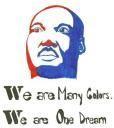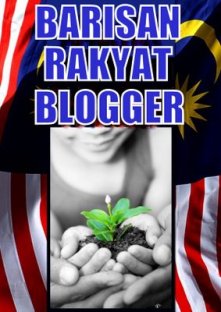
A long long time ago, an Asura (demon) king called Mahabali ruled Kerala. He was a wise, benevolent and judicious ruler and beloved of his subjects. Soon his fame as an able king began to spread far and wide, but when he extended his rule to the heavens and the netherworld, the gods felt challenged and began to fear his growing powers. Presuming that he might become over-powerful, Aditi, the mother of Devas pleaded with Lord Vishnu to curtail Mahabali's powers.In Malaysia, this is how Onam is celebrated (from here):
Vishnu transformed himself into a dwarf called Vamana and approached Mahabali while he was performing a yajna and asked for alms. Pleased with the dwarf brahmin's wisdom, Mahabali granted him a wish. The Emperor's preceptor, Sukracharya warned him against making the gift, for he realized that the seeker was no ordinary person. But the Emperor's kingly ego was boosted to think that God had asked him for a favor. So he firmly declared that there is no greater sin than going back on one's promise. He kept his word.
The Vamana asked for a simple gift — three paces of land — and the king agreed to it. Vishnu in the guise of Vamana then increased his stature and with the first step covered the sky, blotting out the stars, and with the second, straddled the netherworld. Realising that Vamana's third step will destroy the earth, Mahabali offered his head as the last step.
Vishnu's fatal third step pushed him to the netherworld, but before banishing him to the underworld Vishnu granted him a boon. Since he was attached to his kingdom and his people, he was allowed to return once a year from exile. Onam is the celebration that marks the homecoming of King Mahabali. It is the day when a grateful Kerala pays a glorious tribute to the memory of this benign king who gave his all for his subjects.
Another Legend
Another legend has it that King Mahabali was a devout worshipper of Lord Vishnu. He was sincere, honest, just and a good ruler. But he had one weakness — ego. And to eradicate his pride and redeem his beloved devotee of this one sin, Vishnu came to earth in the form of a dwarf Brahmin named Vamana.
The king in his pride asked the Brahmin what he wanted for he could give anything. Vamana asked for three paces of land and the king agreed. To humble him Vishnu, as Vamana showed Mahabali that he is just a puny creature in front of God's universal stature.
Mahabali, who was a man of principles, realized God's purpose and offered his head for Vamana's footstep, as he was sent to another world. This fatal step proved a blessing in disguise for the good king — the foot salvaged and released him from the recurrent cycle of birth and death. That is why Onam is celebrated by wearing new clothes and resolving to lead a new life of truth, piety, love, and humility.
The first day begins with members of the family having a bath. However, unlike other communities, the Malayalees do not have an oil bath.Wishing Thiruonam Aashamsakal to all!
Nambiar said oil is used for cleansing purposes so the people in Kerala have an oil bath every day except on auspicious days.
After this, a unique Kolam (colourful design) made from fresh flowers called Pookalam is placed in front of the house. Since it is the harvest festival, the state of Kerala is a riot of colours as the fields are golden and full of fruits and flowers.
“Each day more flowers are added to the Pookalam. Women use different colours of the same flower or different flowers to brighten the kolam,” he said.
He added that the Pookalam would be placed on sand so each day the ladies would sprinkle water on the flowers to keep them fresh.
A replica of King Mahabali called the Matheva is placed in the centre of the Pookalam. They do this in the hope that Mahabali would be pleased with their efforts and greetings.
Most important is the Onasadya or a feast comprising of vegetarian dishes for everyone.
Onam also means new clothes for everyone in the family and most times it would be traditional outfits.
The women and the men wear an interesting costume called the Mundu.
The Mundu is two pieces of white material with interwoven gold threads and the women wear them with the auspicious gold, red or yellow blouses. People also refrain from wearing black.
They also refrain from sweeping the house and gifts are given to workers and labourers in the farm.
In Malaysia, since most Malayalees do not have holidays for Onam, the celebration is held on the weekend closest to Onam.
The local Kerala associations or samajams hold special events for members in their respective states.
Malaysians would have the onasadya (feast) at home or even at the samajams.
Some of the most important dishes are rice, sambhar, avial, pulicherry, kalan, olan, upperi, meerku varati and savoury inji puli.
“Since it is the harvest festival, the dishes will definitely have rice. Usually the samajams will also organise lunches and usually it would be pot luck,” he said.
There must also be two sweet desserts called payasam which come in two colours, the dark payasam (prathaman) and white payasam (velethe payasam).
All over Malaysia, the samajams would organise cultural performances by local talents. Among the Kerala art forms presented here are Onnamthullal, Kaikotti Kali and Mohini attam.
Sincerely,
Malaysian Heart
P.S. You can read more about Onam here and here.






















No comments:
Post a Comment
How to Paste Text into Comment Boxes
Google seems to have disabled pasting text (including ctrl-v) into blogger comments boxes in Firefox. The good news is that:
1. You can still copy paste using Internet Explorer (I successfully tried it with IE7)
2. With Firefox, you can still "Drag and Drop" text into the comment form. I have successfully dragged and dropped text from MS Word, websites (HTML) and from ScribeFire (plain text and HTML). Just do the following:
a) reduce the size of the window you want to take the text from, and place it near the comment box
b) Highlight the required text with cursor
c) Click on the highlighted text and drag it over to the comment box and drop it there.
Happy commenting!